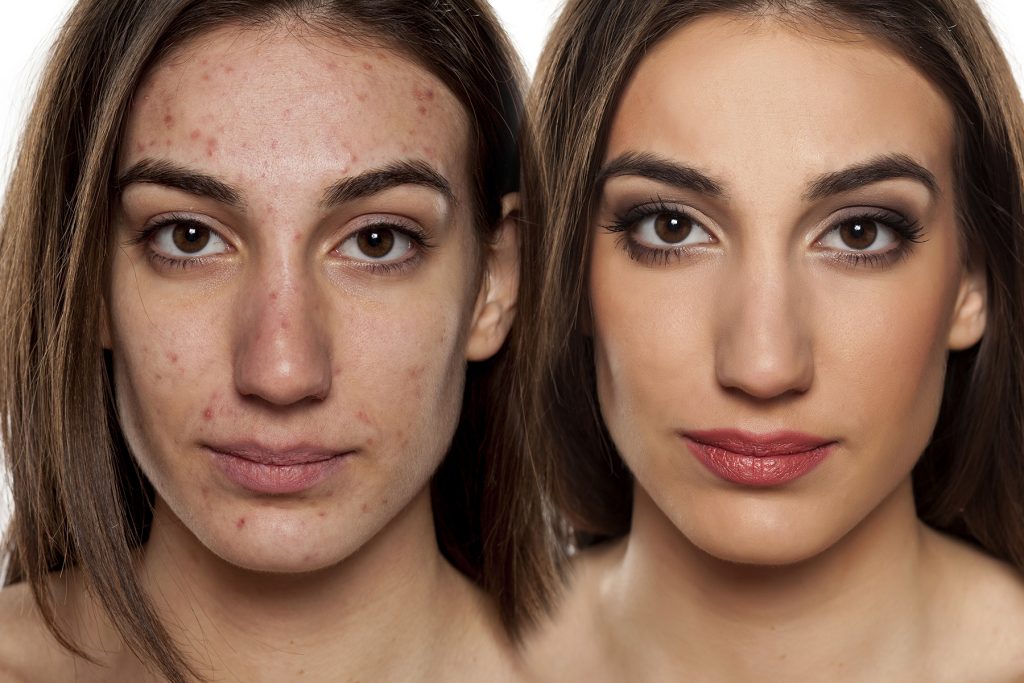
Acne is a very common problem, and the treatments vary from simply improving your skin care regimen, to costly medical procedures. Some acne is serious enough to warrant treatment from a dermatologist or other skin care specialist, and some can be handled at home. In either case, proper diet, drinking plenty of water, and cleaning your skin properly, not necessarily more often, will contribute to the solution.
Types of Acne
There are several types of acne. Some are simply clogged pores while others contain inflammatory bacteria. Understanding the difference between the various types can aid in choosing the proper treatment method.
Comedones – Whiteheads and Blackheads – The most well-known forms of acne are comedones. Whiteheads are closed comedones and blackheads are closed comedones. Both are clogged pores, follicles that are filled with sebum and sloughed off cells. Whiteheads are closed off and have not been exposed to air. Contrary to popular belief, blackheads are not dark because they are just dirt ground into open pores that can simply be scrubbed away. Blackheads are whiteheads turned black because they are exposed to air and oxidize.
Papules – Papules are red or pink bumps that never seem to “come to a head.” Papules are clogged pores or sebaceous glands that are infected with bacteria. They are often tender, and appear to be a whitehead in formation, but it is important not to squeeze or try to force a papule to the surface, as that can cause scarring or further infection.
Pustules – Pustules may at first glance appear to be whiteheads, but they are different. They are yellow or white at the center, but have a pink or red base. These are inflammatory and infected with bacteria. They can leave scar.
Nodules and cysts – Larger than other acne formations, nodules and cysts are more like boils. Both can be very painful, infected with bacteria, can last for months, and are subject to collapse and can cause severe scarring. They both form hard lumps and should be treated by a dermatologist. The primary difference between them is that cysts fill are filled with pus.
Things you can do for yourself include:
- Reduce stress
- Drink plenty of water
- Shower immediately after working out
- Wash and moisturize your face daily, but no more than three times a day
- Exfoliate
- Eat healthy foods
Topical treatments
Topical treatments include:
Retinoids – derivatives of Vitamin A that help to unblock pores. They are available in over-the-counter and prescription forms, usually as a cream containing retinol or retinaldehyde. Retinoids can increase the chance of sunburn.
Benzoyl peroxide – available over-the-counter or in a stronger prescription form. It works by helping to unblock pores and killing bacteria.
Antibiotics/Anti-inflammatories – kill bacteria and sooth as well as reduce swelling and redness.
Azeliac acid – kills bacteria and decreases the production of keratin.
Oral medications
Antibiotics work by reducing bacteria from the inside. This is an effective way to reduce acne, but can have side effects such as increased chance of sunburn and yeast infections. Birth control pills can reduce or stop acne by regulating the hormones which increase the production of sebum causing breakouts.
Triamcinolone Acetonide Injections
Triamcinolone acetonide is a corticosteroid which is injected directly into acne legions. This anti-inflammatory works well on cystic acne that has not responded to other treatment.
Laser Treatments
Laser treatments kill the bacteria and alter the sebum gland, resolving existing acne and reducing the production of sebum to prevent its return. Most patients will need several treatments about two weeks apart for full results.
Photo Therapy
Red and Blue light kill the bacteria associated with acne, and promote healing of the skin. The treatment is gentle and painless. In-office treatments resolve acne in about four weeks with treatment at intervals of twice a week. Photo therapy at home normally requires daily sessions for about 12 weeks. Photo therapy is not appropriate for cystic acne, but is very effective for persistent mild to moderate acne. Read this article to learn more about light therapy for persistent acne.
Zeno Zit Zapper
This hand held device is used at home to resolve individual blemishes. It does not cure acne. Treatments last about two to three minutes and should be repeated every hour for two to four hours. Heat kills the bacteria in the blemish and most will be resolved or reduced in 24 hours. While this will not stop your acne from reappearing, it can be useful if you have a breakout shortly before a big event. For more information on laser treatments for acne, read this article.
Related articles




